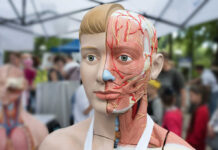
Deep vein thrombosis (DVT) is a condition that falls under venous thromboembolism, which is a blood clot disorder, and is when a blood clot forms in a deep vein. DVT derives its name from the area of the body that is affected, deep veins, and thrombosis, which is a combination of the root word “thrombus” and the suffix “osis.” Thrombus is the term used for blood clots that form inside of your veins and “osis” is a suffix meaning a condition or an abnormal state of. So put together, the condition means an abnormal state of blood clots in deep veins. A deep vein is one that isn’t close to the skin’s surface like superficial veins are.
DVT can cause a complete blockage of blood flow, or may just cause a partial one, and while they most commonly occur in the lower leg, thigh or pelvis, they can also develop in other parts of the body like arms or internal organs.
Cleveland Clinic reports that approximately one to three in every 1,000 adults develop one of the conditions of venous thromboembolism each year and up to 300,000 people die as a result of the condition. It can sometimes go undetected and can affect anyone, although there are certain risks associated with the disorder.
The dangers of DVT are serious in that it can result in death; however, it’s important to note that the condition can be treated and prevented with things like diet and exercise.
So what are some of the dangers and complications of DVT? John Hopkins Medicine lists the two most common complications being chronic venous insufficiency and post-thrombotic syndrome.
Chronic Venous Insufficiency
Once a blood clot appears in the veins of the lower limbs, the vein no longer works to its full capacity, meaning it doesn’t pump blood through the body well. When a vein isn’t pumping the blood, blood can start to collect, resulting in pain and swelling. This can become a chronic issue meaning it happens regularly.
Post-thrombotic Syndrome
This syndrome occurs when complications of DVT linger. Similar to chronic venous insufficiency, the post-thrombotic syndrome can cause pain, swelling, tenderness, and redness, as well as ulcers. Because the disorder often affects the lower limbs, everyday activities like walking are affected and become challenging.
And finally, as mentioned before, DVT can result in death when the blood clot travels to the lungs, which can prevent oxygenated blood from circulating through the body. This is known as a pulmonary embolism (PE) and is the other condition that falls under venous thromboembolism.
Remember that these disorders are preventable and treatable, especially with regular checkups and being aware of sensations in your body. Dizziness, shortness of breath, swelling, and tenderness of the leg should always be checked out by a doctor, and supervision after a heart attack or major injury is always recommended.



















